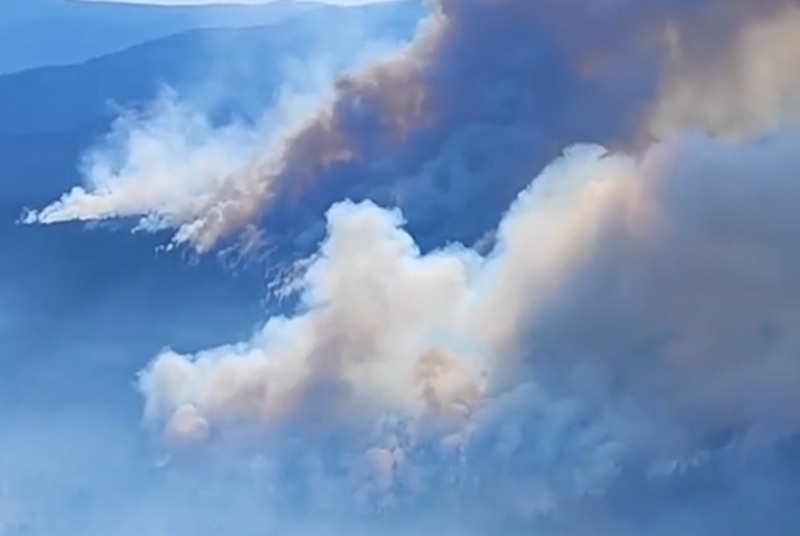Heat, drought hamper efforts to control fires burning near Slocan Valley homes
Hot and dry weather is expected to stay in effect for the next 10 days as the B.C. Wildfire Service struggles to gain control of several fires of note, including one that forced the evacuation of the village of Slocan.
And the culprit for the three major fires burning in the valley — thunderstorm with dry lightning — is expected to revisit the scene of the crime Tuesday, with little (1 millimetre) to no rain associated with the storm.
Although the number of fires had been slowly tracking downward after a brief cool spell that brought some precipitation, the weekend has brought a renewed vigour to the number and appetite of the wildfires. There are now 85 fires wildfires currently burning in the Southeast Fire Centre — up from 75 two days ago — with four wildfires of note and 62 listed as out-of-control, up from 55 on Thursday.
In order to gain some headway on the Ponderosa wildfire burning southwest of Slocan, the BCWS has set a prescribed burn in the area, which was revealed Sunday night in a community meeting at the Winlaw Elementary School.
The strength and severity of the fires has also continued the closure of Highway 6 in both directions (north and south), from one kilometre south of Silverton to 11 km south of Slocan, encompassing Brandon and Lemon Creek.
Smoke from the fires continues to be a concern as it creates a high health risk. The fine particles in wildfire smoke pose the main health risk — and can get into the bloodstream — with people most impacted by the smoke including seniors, pregnant women and young children. People who work outdoors and are involved in strenuous outdoor exercise, or have an existing illness or chronic health condition, could also be impacted negatively.
The cool spell allowed the BCWS to downgrade an evacuation order on July 30 for Silverton to evacuation alert — due to the Aylwin Creek fire — allowing residents from 185 properties in the village and 17 properties in the surrounding area in electoral Area H to return to their homes. It also allowed the evacuation order and alert to be rescinded for New Denver and the rural area just outside of the village.
Combined with the record-breaking temperatures in July 2024 and ongoing drought, people are encouraged to be prepared for the continued higher risk of wildfire in the province.
All open burning, including campfires, continues to be prohibited in southern B.C.
For residents on evacuation order
People may be reluctant to leave their homes and community if an evacuation order is delivered, but choosing to remain in the area comes with some considerations, including:
- services, utilities and businesses normally relied upon may be unavailable or shut down;
- evacuation routes can change or become impassible;
- emergency medical services may not be able to reach an evacuation order area because of a risk to their own safety or access is blocked; and
- friends and family will not be allowed to temporarily access the evacuation order to re-supply you if you stay.
Source: Regional District of Central Kootenay
Temporary access permit
Temporary access permits (TAP) are restricted to the following:
- critical infrastructure or utility agencies may require access in order to service (ie. refuel, inspect) or make repairs to affected critical equipment and sites;
- members of the agriculture sector may need to make essential repairs to fencing, evacuate or check on livestock condition and care as required; and
- community members may request access so they can retrieve important medication, tend to their domestic animals.
Source: Regional District of Central Kootenay
Emergency support
Emergency support services provides support to evacuees who need assistance meeting their basic needs, such as food, lodging and incidentals.
People can register for emergency support services by visiting a reception centre, phoning the BC evacuee helpline or through the website: https://ess.gov.bc.ca/
Information about the location of reception centres, including routes to the centres, is provided within evacuation orders issued by local governments and First Nations. Orders can also be found here: https://www.emergencyinfobc.gov.bc.ca/
During major evacuations, people may be able to access ESS supports via Interac e-transfer. Online registration for ESS supports has been activated for people evacuated throughout the RDCK.
To access supports online, people will need to create a profile on https://ess.gov.bc.ca/ and authenticate it with their B.C. Services Card app. After logging into the website, they will be asked a few questions before being provided with instructions about how to access Interac e-Transfer supports.
People are encouraged to create an ESS profile before they are placed under an evacuation order or evacuation alert.
For information or for assistance receiving supports, people can call the B.C. evacuee helpline at 1 800 387-4258.
Resources
- How to prepare for heat and tips about how to stay safe.To access the guide, visit: https://PreparedBC.ca/ExtremeHeat
- For the latest information about the current wildfire situation, including fire bans and restrictions, in B.C., visit: https://bcwildfire.ca
- For the most up-to-date information about wildfire activity in B.C., visit: https://wildfiresituation.nrs.gov.bc.ca/dashboard
- For information about active evacuation orders and evacuation alerts, visit: https://www.emergencyinfobc.ca/
- To check current weather alerts, visit: https://weather.gc.ca
- To view air-quality advisories, visit: https://www2.gov.bc.ca/gov/content/environment/air-land-water/air/air-quality/air-advisories
- For preparedness guides from PreparedBC, including floods, wildfires and extreme heat, visit: https://www.preparedbc.ca
- For tips about how to prepare grab-and-go bags, visit: https://www.preparedbc.ca/emergencykit
- To find BC Centre for Disease Control information about preparing for heat events, visit: http://www.bccdc.ca/health-info/prevention-public-health/preparing-for-heat-events

























